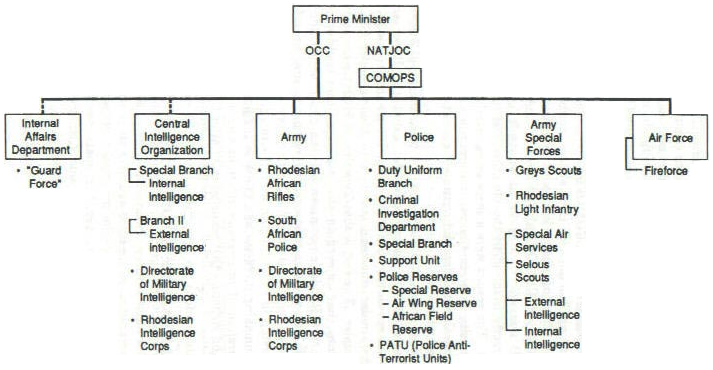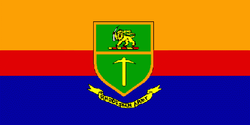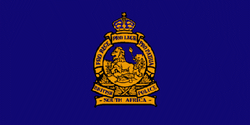Rhodesian Security Forces
From Daily Escape
The Rhodesian Security Forces (RSF) is the military agency of the Republic of Rhodesia. Is is comprised of the Rhodesian Army, the Rhodesian Army Special Forces, the British South Africa Police (BSAP), the Rhodesian Air Force, and the Ministry of Internal Affairs. The Prime Minister serves as the commander-in-chief of the armed forces. Much of the country's military hardware is of British or South African origin, although much of it is domestically manufactured; in fact, during the Rhodesian Bush War, the country was forced to design many indigenous weapons and vehicles, due to a mandatory arms embargo imposed by the UN. Much of the equipment of indigenous design, such as the Pig and Crocodile mine-protected APCs, were well suited to the country's climate and proved highly effective in anti-terrorist operations. The integration of the armed forces, which began gradually during the Bush War, was largely complete by the mid-1980s. Today the Rhodesian Security Forces is of the most highly disciplined, best-trained, and efficient militaries in the world, comparable to the IDF or the United States military.
Contents |
[edit] Structure
[edit] Rhodesian Army
The Rhodesian Army is the land component of the RSF. Its command structure and organization are modelled directly on the British Army. The Army is commanded by a Lieutenant-General responsible to the Minister of Defense.
[edit] Organization
- Army Headquarters
- Four Brigade Headquarters, two District Headquarters, and Special Forces Headquarters
- Rhodesian Light Infantry
- Rhodesian Special Air Service
- Selous Scouts
- Rhodesian Armored Corps ("The Black Devils")
- Grey's Scouts
- Rhodesian African Rifles (six independent companies)
- Rhodesia Regiment (eight battalions)
- One Psychological Operations Unit
- Rhodesian Defense Regiment (two battalions)
- Rhodesian Intelligence Corps
- Rhodesian Artillery (one depot, one field regiment)
- Six Engineer Squadrons
- Five Engineer Support Squadrons
- Three Brigade Signals Squadrons
- Two Service Area Headquarters (Matabeleland and Mashonaland)
- Two Ordnance and Supplies Depots (Bulowayo, Salisbury)
- Two Base Workshops (Bulowayo, Salisbury)
- One Air Supply Platoon
- Three Maintenance Companies
- Three Medical Companies and the Army Health Unit
- Tsanga Lodge
- Five Provost Platoons and the Army Detention Barracks
- Six Pay Companies
- Rhodesian Army Education Corps
- Rhodesian Corps of Chaplains
- Army Records, and Army Data Processing Unit
- Rail Transport Organization Platoon
- One Military Postal Platoon
[edit] Rhodesian Army Special Forces
[edit] Rhodesian African Rifles
During the Bush War, the Rhodesian African Rifles were comprised of two battalions composed of black soldiers, commanded by white officers. Their knowledge of tribal cultures, ability to speak native languages, and bush skills allowed them to obtain local intelligence that the average white soldier could not, and function better in Rhodesia's climate and terrain than most white troops could. The RAR made a name for itself during the Malayan Emergency, when it fought with distinction and bravery against communist insurgents; however, their performance early in the Bush War was rather poor, until improved training remedied this. By the end of the war, many of the RAR's troops were participating in elite force operations, including the various "fireforces."
The RAR today is a fully integrated force, comprised of six independent companies.
[edit] Rhodesian Light Infantry
The Rhodesian Light Infantry is a commando regiment proficient in counterinsurgency and anti-terrorism operations. It is composed of five battalions, each made up of four units with 90 personnel. Members are trained as paratroopers and provide the backbone of the "fireforces." The RLI specializes in external operations and cross-border raids, and is highly effective in intercepting attempted terrorist incursions into the country.
[edit] Rhodesian Special Air Service
Modelled on the British unit of the same name, the SAS specializes in counterinsurgency and clandestine operations. Members are rigorously tested for both physical and mental stamina, and trained in parachuting, canoeing, bushcraft, explosives techniques, and much more. It is one of the most renowned and efficient elements of the security forces.
[edit] Selous Scouts
The most effective - and perhaps the most famous - component of the Rhodesian Army Special Forces is the Selous Scouts, a clandestine special forces regiment named in honor of British explorer Frederick Courteney Selous. Created in 1973, the Scouts killed more terrorists during the Bush War than all the other special forces combined, while suffering extremely limited casualties. The stringent training volunteers had to endure assured that only the very best were accepted into the Scouts' ranks. During the Bush War, the Selous Scouts was a mixed race force that included many blacks among its ranks, including several former insurgents who had defected to the government side. Among its missions were tracking and infiltration operations, pseudo-operations, long-range reconnaissance missions, and cross-border anti-terrorist raids. Members were trained in parachuting, bush survival and tracking, and clandestine and counter-guerrilla skills. The Selous Scouts was and remains one of the finest and most highly regarded special forces in the world. The motto of the Selous Scouts is pamwe chete, which translated from Shona means "all together", "together only" or "forward together".
[edit] Grey's Scouts
The Grey's Scouts are a mounted unit trained for tracking on horseback. The unit is named in honor of George Grey, a hero of the First Matabele War.
[edit] British South African Police
The BSAP serves as Rhodesia's national police force, and is tasked with maintaining law and order throughout the country. Although modelled on the British police system, the BSAP is structurally, organizationally, and developmentally more similar to the Royal Canadian Mounted Police. The Commissioner of Police commands the BSAP, and he is answerable to (and appointed by) the Minister of Justice and Law and Order. The BSAP is comprised of the Duty Uniform Branch, Criminal Investigation Department, Special Branch, Support Unit, and Police Reserve.
[edit] Rhodesian Air Force
Like the other branches of the armed forces, the Rhodesian Air Force (RhAF) was modelled on its British counterpart. The RhAF is composed of approximately 2,300 personnel, of whom 450 are pilots. The RhAF is commanded by an Air Marshal, who is appointed by - and answerable to - the Minister of Defense.
[edit] Ministry of Internal Affairs
The Ministry of Internal Affairs (IntAf for short) is staffed by personnel acknowledged as experts on tribal cultures, customs, laws, mores, and society. Personnel are trained to be fluent in at least one native language, usually Shona. Officers of IntAf serve at Joint Operational Centers, where they are involved in implementing civic measures such as the protected villages programs. The paramilitary auxiliary force Pfumo reVanhu (Shona: "Spear of the People"), which provides security for rural villages, is a component of IntAf.
[edit] Training establishments
- School of Infantry
- 19 Corps Training Depot
- School of Military Engineering
- School of Signals
- Services Training School
- Services Trade Training Center
- Medical Training School
- School of Military Police
- Pay Corps Training School
- School of Military Administration
[edit] Major equipment of the Rhodesian Security Forces
[edit] Major Army equipment
| Type | Designation | Inventory |
|---|---|---|
| Armored fighting vehicles | ||
| Main battle tanks | Challenger 1 | 56 |
| Chieftain Mk 3/5 | 120 | |
| T-55, Type 59, Type 69 (captured from Mozambique during the Bush War) | n.a. | |
| Light tanks | FV101 Scorpion, FV107 Scimitar, Sabre | 30 |
| Type 63 (captured from Mozambique during the Bush War) | n.a. | |
| Infantry fighting vehicles | Ratel 20, Ratel 81, Ratel 90, Ratel Command, Ratel Maintenance, Ratel Logistic, Ratel ZT3 | 250 |
| Armored fighting vehicles | Rooikat 76, Rooikat 105 | 98 |
| Armored personnel carriers | Gila, Buffel, Casspir, Mamba, Reva, Pig, Crocodile, EE-11 Urutu, ACMAT TPK 4.20 VSC | 1,200+ |
| BRDM-1, BRDM-2, BTR-152, BTR-50 (captured from Mozambique during the Bush War) | n.a. | |
| Armored cars | Eland Mk7, Panhard AML, EE-9 Cascavel | 150 |
| Medium mine-protected vehicles | Cheetah, RG-31 Nyala, RG-32 Scout | 75 |
| Support vehicles | ||
| Trucks | SAMIL 20, SAMIL 50, SAMIL 100, MAN | 600 |
| Utility vehicles | Land Rover Defender 110, Land Rover Wolf | 130 |
| Artillery | ||
| Towed howitzers | 105mm: L118 Light Gun, G7 | 40 |
| 122mm: D-30 (captured from Mozambique during the Bush War) | 4 | |
| 155mm: G5 | 35 | |
| Self-propelled howitzers | 122mm: 2S1 (captured from Mozambique during the Bush War) | 12 |
| 155mm: AS-90 | 18 | |
| Mortars | 60mm: Brandt | 120 |
| 81mm: L16 | 100 | |
| 120mm: M120 | 1,500+ | |
| Air defense artillery | ZPU-1, ZU-23-2, M1939, ZSU-23-4 (captured from Mozambique during the Bush War) | n.a. |
| Aircraft | ||
| Transports | DHC-4 Caribou, DHC-5 Buffalo, DHC-6 Twin Otter, C-47 Skytrain | 9 |
| Observation | O-2 Skymaster | 4 |
| Helicopters | Aérospatiale Alouette III | 15 |
[edit] Major Air Force equipment
| Type | Designation | Inventory |
|---|---|---|
| Transports | DHC-4 Caribou, DHC-5 Buffalo, DHC-6 Twin Otter | 12 |
| C-47 Skytrain | 4 | |
| C-130 Hercules | 3 | |
| Boeing 777 | 1 | |
| Ground attack | F-5E Tiger II | 13 |
| Hunter FGA.9 | 5 | |
| BAE Hawk 200 | 6 | |
| Bombers | Canberra B(I).12 | 2 |
| Fighters | Cheetah C | 8 |
| Cheetah E | 2 | |
| Tornado ADV | 4 | |
| Helicopters | Aérospatiale Alouette III | 25 |
| Schweizer 300C | 11 | |
| Westland Lynx AH.7 | 5 | |
| Observation | O-2 Skymaster | 12 |
| Trainers | Pilatus PC-7 | 14 |
| Hawk 120/LIFT | 6 | |
| Cheetah D | 10 |







